- What is ChatGPT?
- History Of ChatGPT | The New Face Of AI
- How Does ChatGPT Work? What Makes The Bot Talk!
- What Is ChatGPT Written In & Trained On?
- How You Too Can Access ChatGPT?
- How To Prompt ChatGPT To Do Your Bidding?
- What is ChatGPT used for? Applications of ChatGPT
- Limitations of ChatGPT
- Versions of ChatGPT
- What is ChatGPT 4? How Does It Differ From ChatGPT-3?
- Is ChatGPT The Only Way To Go?
- Frequently Asked Questions (FAQs)
What Is ChatGPT? Can It Be Your New Best Friend?

“The development of full artificial intelligence could spell the end of the human race. It would take off on its own and re-design itself at an ever-increasing rate. Humans, who are limited by slow biological evolution, couldn’t compete and would be superseded.” - Stephen Hawking
The words by The Big Bang Theory's favorite theoretical physicist paint a morose picture that should have many shaking in their boots. However, this is not what we saw with the launch of ChatGPT, the AI tool that's all the rage today. So, have you tried it out yet? Or are you still wondering what is ChatGPT and how you, too, could get a taste of the chatbot?
Irrespective of whether you have already taken ChatGPT out for a round or not, this article will have something new for you to learn. Here you will find everything you need to know about ChatGPT, how it works, its applications, and much, much more. So what are you waiting for!
What is ChatGPT?
First things first, the full form of ChatGPT is Chat Generative Pre-Trained Transformer, with the GPT component of it being OpenAI's language models, which forms the foundational basis of the tool. ChatGPT is Open AI's golden boy- an artificial intelligence chatbot that has been trained on large quantities of data. The bot takes this data and transforms/ presents the text in a way that's most suitable for its user. It has natural language capabilities, meaning it can carry on human-like back-and-forth conversations with users. We will explore this artificial intelligence model and its capabilities in greater detail ahead.
About OpenAI
OpenAI started as a nonprofit venture in December 2015, with Sam Altman, Reid Hoffman, Elon Musk, Greg Brockman, Jessica Livingston, Peter Thiel, Amazon Web Services, and others serving as the primary initiators and board members. Currently, OpenAI is an AI research lab comprising OpenAI Incorporated (the non-profit arm) and OpenAI Limited Partnership (the for-profit subsidiary). In 2019, Microsoft also invested $1 bn in OpenAI LP and $10 bn in 2023.
History Of ChatGPT | The New Face Of AI
While the ChatGPT craze is relatively new, the artificial intelligence model has been around since 2018. Surprised!
OpenAI started as a non-profit organization for collaboration purposes and has been working on developing artificial intelligence technology since its inception in 2015.
- In 2018, the entity released the first version of what we know as ChatGPT today, only at that time, it was just GPT, i.e., Generative Pre-Trained Transformer. OpenAI's GPT model is the foundation of ChatGPT, the chatbot that has captured everyone's attention.
- GPT is an AI algorithm and language model which understands human-like language and hence also has the ability to generate human-like responses. The models imbibe deep learning principles to analyze large amounts of data to learn and grow.
- The GPT platform is trained with Reinforcement Learning from Human Feedback (RLHF) which breaks information fed to it into parameters and then analyzes them to come up with responses.
- In the first iteration of ChatGPT, i.e., GPT worked with 117 million parameters. OpenAI then released GPT-2 with 1.5 billion parameters in 2019. However, at this point in time, the AI model had little to no public exposure.
- Irrespective, the potential of these platforms garnered much-needed attention and got the backing OpenAI needed to launch the third and the largest iteration of the language model- GPT 3 in 2020 with 175 bn parameters. OpenAI then launched InstructGPT in 2022 based on GPT-3.
- And just a few months later, they finally launched ChatGPT in November 2022. The name combines the words "Chat" and "GPT", indicating that it is a chatbot build on the foundation of GPT, or GPT-3.5 to be specific.
- The initial release of ChatGPT-3/ ChatGPT-3.5 gained immense popularity and was used widely across the world. Its ability to articulate human-language-like responses had drawbacks too. For example, it sometimes gave nonsensical answers and shared incorrect information.
- The progress and limitations brought to the fore with continued use of the chatbot spurred the release of another, more refined, and currently the latest version of the bot- ChatGPT-4 in March 2023.
OpenAI is working round the clock to collect more data from the user responses and interaction with ChatGPT to refine its approach and improve its performance.
How Does ChatGPT Work? What Makes The Bot Talk!
As we've mentioned before, ChatGPT is trained as per the RLHF method.
- Therein, human AI trainers act as a chatbot and a human and play out a conversation. They are provided with model-written suggestions to help frame responses in the interaction, which is then fed to the AI chatbot.
- The transcripts of these conversations become the dataset for ChatGPT. The AI model then analyzes the data, recognizes the pattern in it, and stores them as parameters.
- The AI chatbot is then asked to generate outputs for various worded prompts based on the parameters it has stored. These responses are further analyzed by humans to adjudge quality.
- OpenAI has created a reward model to reinforce learning for the AI chatbot. For this, they collect comparison data from two or more AI responses that trainers rank by quality.
- Ranking the AI responses on quality helps the AI adjust its parameters which are an important foundation of the language model ChatGPT is based on. Multiple iterations of the process are carried on to refine the quality of responses.
- This is how OpenAI uses the reward model to fine-tune ChatGPT's training and enhance its performance as per the Proximal Policy Optimization.
All in all, ChatGPT analyzes the writing style, grammar, and context of the prompts given by users. It then uses AI-generated content to formulate responses in a conversational format with the help of its natural language capabilities. While such advanced models have previously been in existence, and there is a long way to go in terms of AI technology, the experience ChatGPT offers is a notch above everything else that we have seen so far.

What Is ChatGPT Written In & Trained On?
ChatGPT, the natural language processing (NLP) chatbot with advanced capabilities, is written in Python, PyTorch, and TensorFlow as core languages. While these three programming languages make up the base code and other algorithms/ functionalities of the bot, multiple NLP libraries and frameworks are at play here. Frameworks, including Gensim, spaCy, OpenNMT-py, NLTK, etc., are used to enhance the capabilities of the model. The Dialogflow and Wit.AI libraries enhance their speech recognition and such abilities.
In addition to this, ChatGPT uses many other languages, open-source libraries, and frameworks to enhance and extend its capabilities as well as increase the efficiency and accuracy of its solutions.
In terms of training, the chatbot is built on the Large Language Model (LLM), and trained with natural language processing techniques, deep machine learning models, along with the RLHF. The neural networks of the bot are trained on an extremely vast quantity of information/ texts from the internet, books, news articles, blogs, and many other such sources. As per resources, the database for both consisted of 570GB of data and 300 billion words. The learning models combined with the database give ChatGPT the ability to learn about countless topics and understand users' prompts and respond appropriately in real-time.
How You Too Can Access ChatGPT?
ChatGPT-4 is currently available for free for all users across the world. All you have to do is sign up on the website, and you can go to town with it. Here is how to use ChatGPT:
1. First, visit the official website and click on the tab 'Try ChatGPT'. It will take you to the login/ signup page.
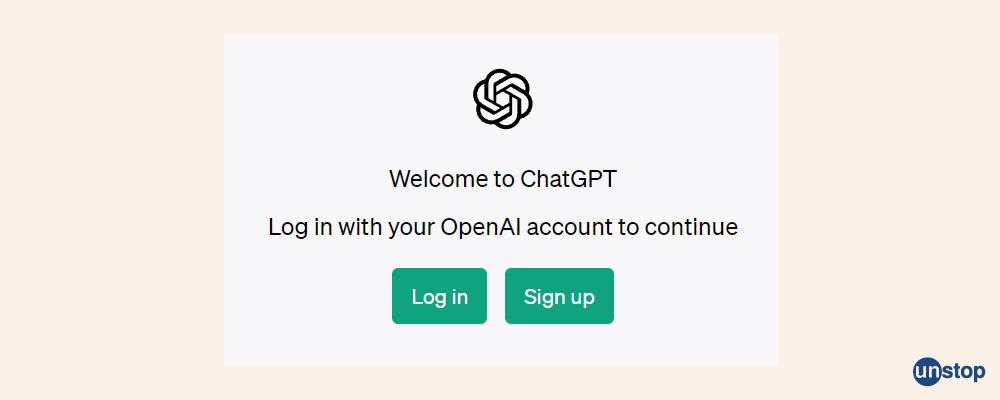
2. To sign up, you first have to fill in an email address, create a password, and then verify the email address.
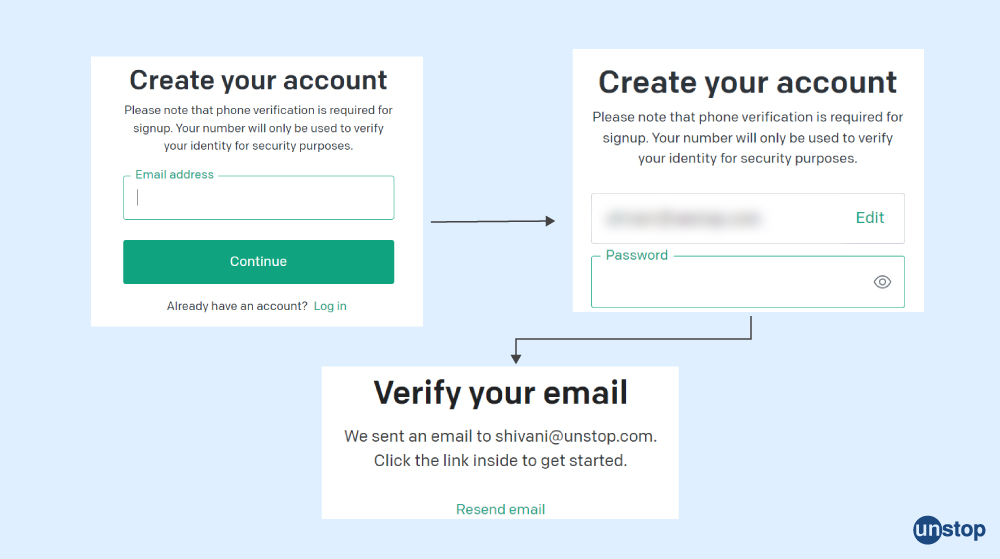
3. Then fill out the personal information (i.e., your name and birth date), and verify your contact number.

4. Once you have signed up, the portal will take you to the ChatGPT interface and prompt a few disclaimers that you must take note of.
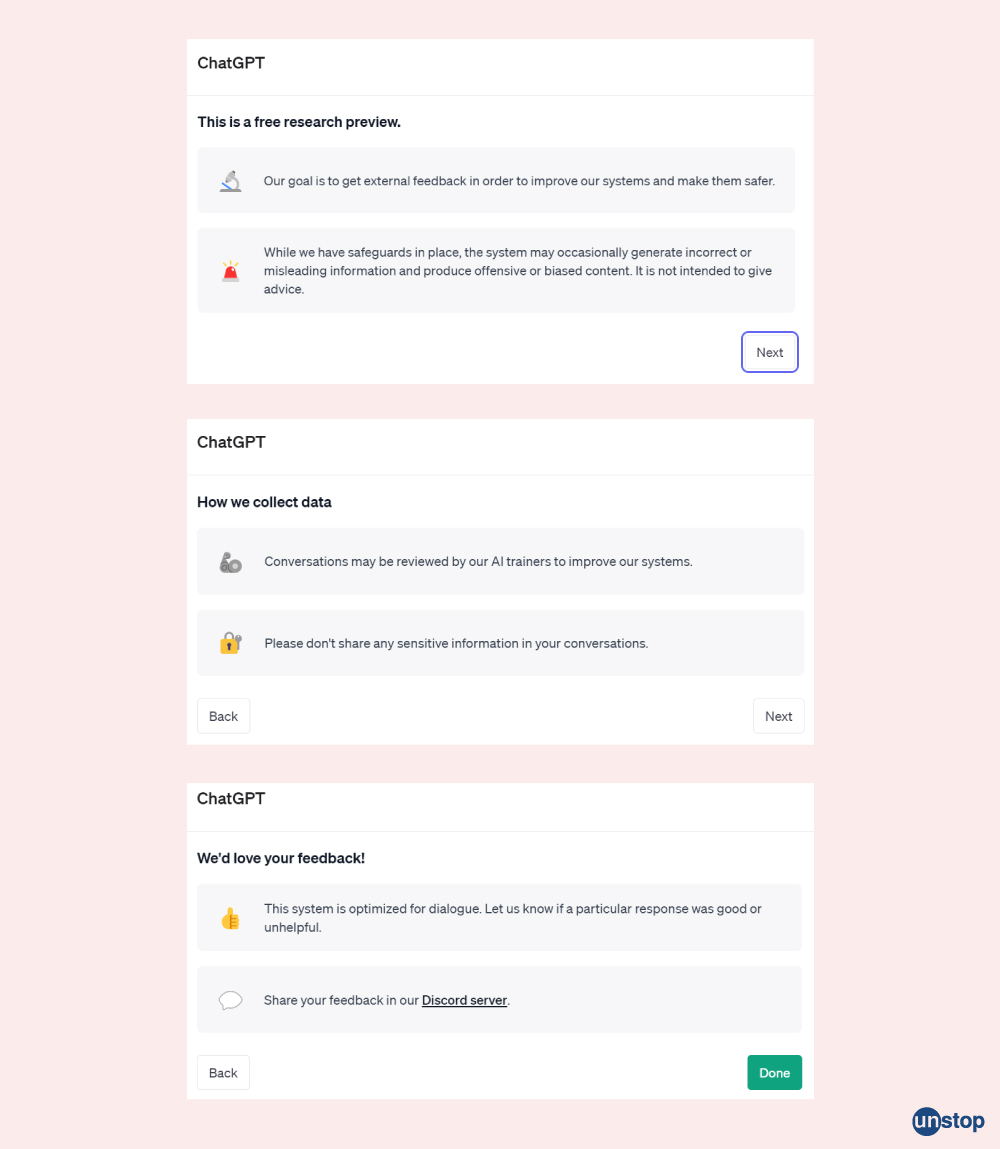
5. Viola! You are ready to converse with ChatGPT, so feed in your prompt now.
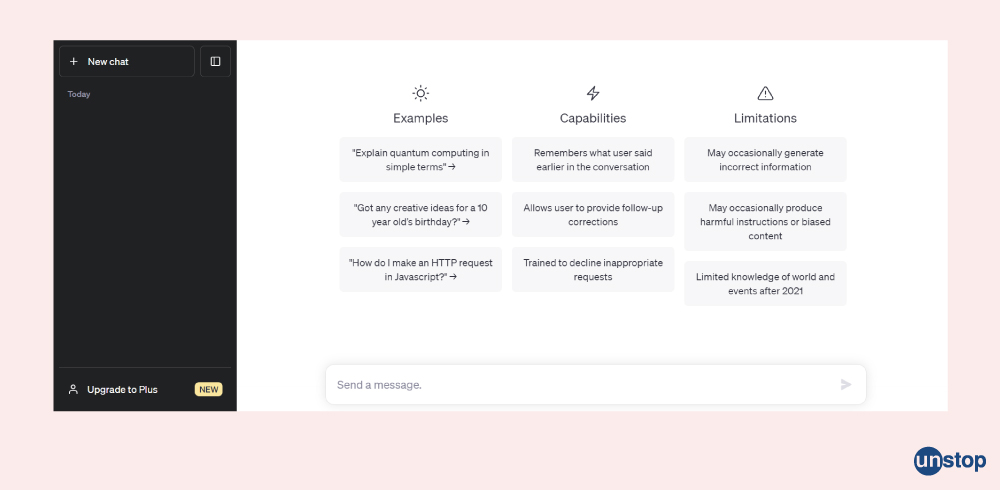
How To Prompt ChatGPT To Do Your Bidding?
One of the most important aspects of getting the best response out of this AI tool is knowing how to feed in the proper, worded prompts to get what you are looking for. Note that the chatbot can remember questions/ conversations and can respond to follow-up questions accordingly. For example, we asked the bot- 'What is ChatGPT?'. This is the response we got-
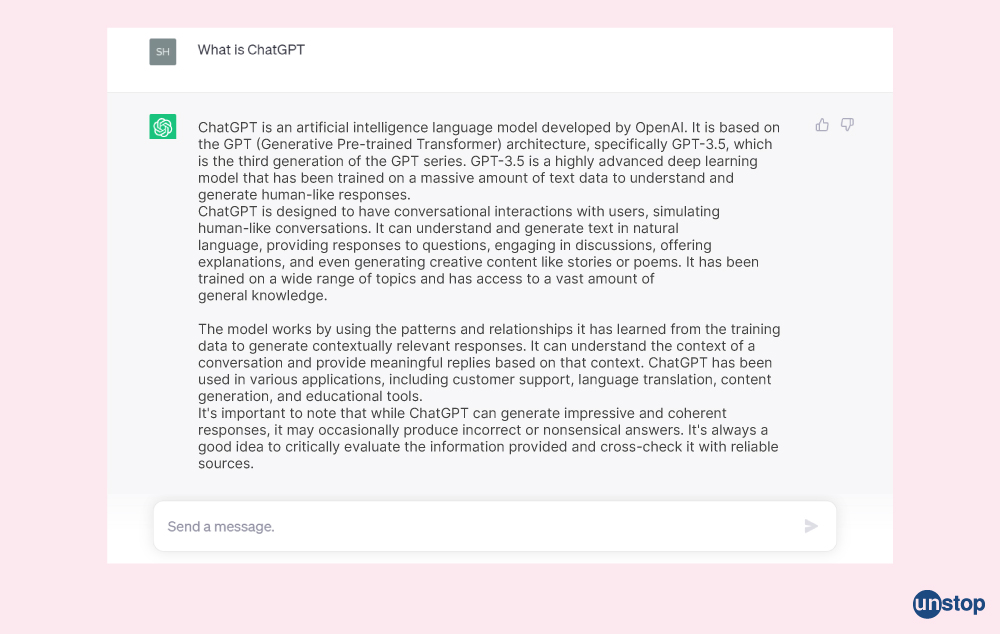
We then asked the bot to humanize its answer, and this is what we got-
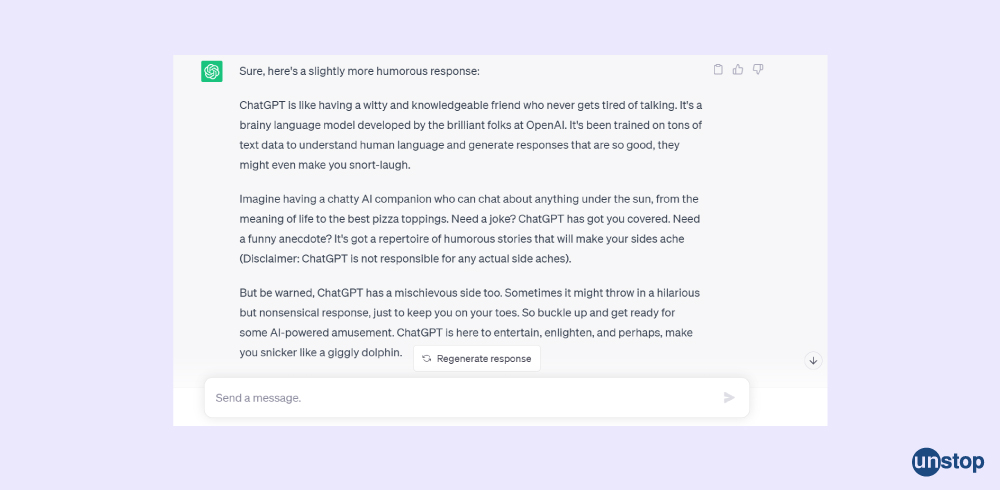
We know that ChatGPT analyses the writing style and context to come up with an appropriate response. It is hence important to formulate your prompts to give all the signals you can to the AI bot. In another example, we asked ChatGPT- How is Indian tea made? Here is the response we got-
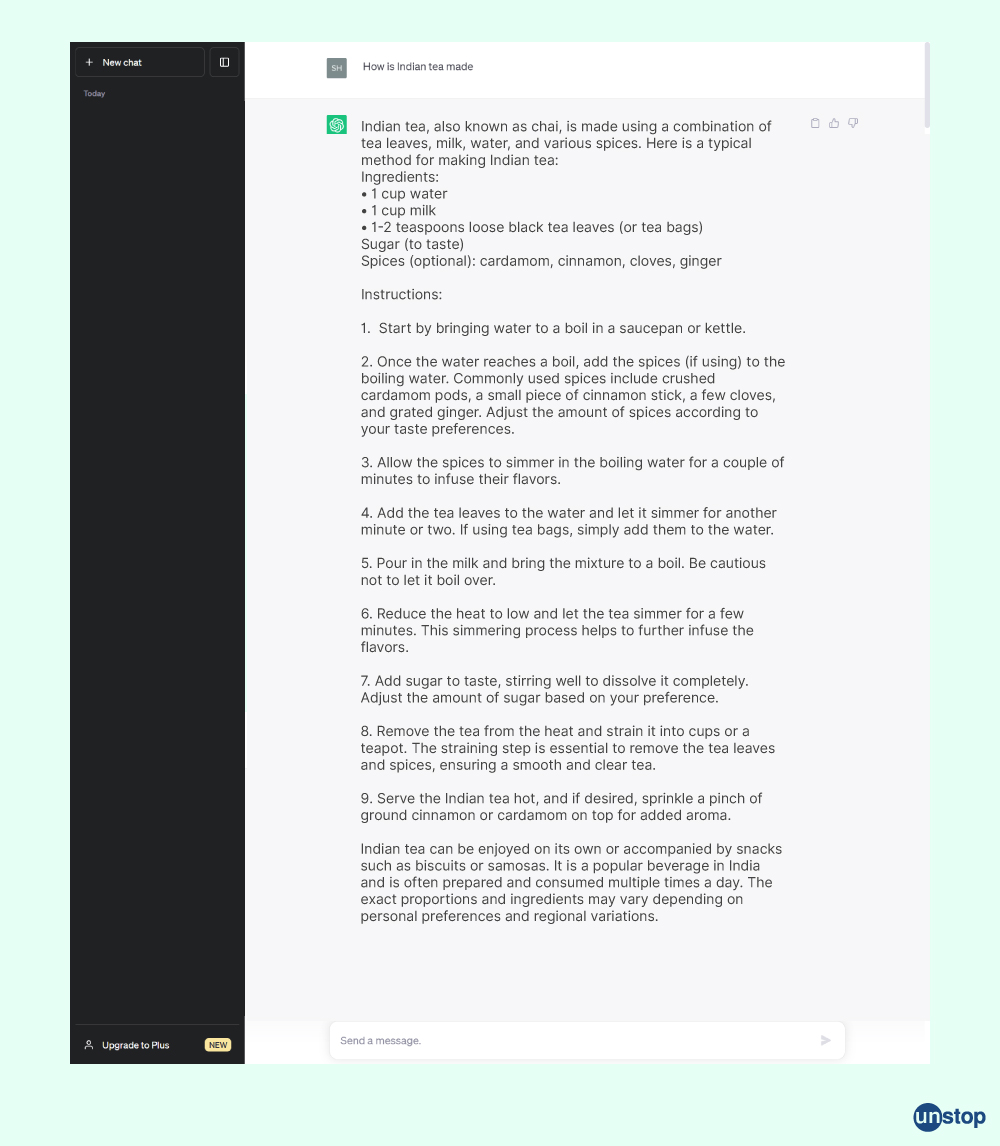
We then reframed our question to- Explain how Indian tea is made. And here is the response we got-

Read more about this at- A Quick Introduction to Prompt Engineering In ChatGPT For Success
What is ChatGPT used for? Applications of ChatGPT
Since its initial launch in November 2022, people around the globe have been experimenting with the AI chatbot and discovering its uses and applications. While some students are using it to get their homework done, creatives are experimenting with it to write poems, get suggestions, creative ideas, and story ideas, and some are even using it to get an easy explanation of complicated concepts like quantum physics, etc.
The short version of this story is that there is a wide range of uses of ChatGPT, and they are bound to grow with time. Here are some common uses:
- ChatGPT is a multilingual bot, and that naturally means one of its uses is to fulfill translation tasks.
- The chatbot has the ability to explain even complex topics with ease if the prompt is worded properly. It can also generate essay content, help write research papers, and more. It can be a great tool for skill development and more in students when used correctly.
- Not only students, educators, and teachers can also make use of ChatGPT to create lesson plans, write test papers, and more.
- When we are talking about AI, the fact that the bot can write codes in multiple languages is naturally one of its more prominent uses.
- The bot's analysis skills are useful for many professionals, as well as students. One easy application of this ability is- it can analyze technical documents.
- ChatGPT can also help carry on exploratory data analysis and assist users with data visualization.
- The AI chatbot can help facilitate operations in many industries, including the healthcare industry, human resource management, financial analysis, customer service, data scientists, etc.
- The applications and uses of ChatGPT in the creative industry are also widespread. It can generate creative content like marketing campaigns, advertisements, video scripts, etc. Creative content writers & copywriters, as well as graphic designers, can certainly make some parts of their jobs easier with the help of this AI tool.
- ChatGPT can help job seekers tackle the various stages of the hiring process, starting from writing the perfect resumes and cover letters to building a portfolio.
- It's not all about work, that is, you can make use of ChatGPT to get suggestions on how to spend some free time, which movies or shows to watch, etc. In fact, the tool can also help you figure out how to make that favorite beverage or food item.
OpenAI's chatbot can be a good addition to one's personal as well as professional life. It can facilitate work and optimize the learning experience across industries and domains. But that does not mean that the bot is without any fault, does it?
Limitations of ChatGPT
The whole of the AI industry is a work in progress. And the same applies to ChatGPT, with some of its limitations being-
- There is a possibility that ChatGPT will give nonsensical answers or incorrect responses, which sound plausible if you don't have prior info. Given that there is no source of truth in its RL training, this is one of the limitations faced when using the AI chatbot.
- If the question/ prompt given to the bot is a little ambiguous or confusing, rather than asking questions to get clarity of what the user is seeking, the bot uses guesswork to give answers. This may result in the bot supplying incorrect information.
- The model has an affinity to verboseness, and it repeats phrases in an effort to sound more humane, but that mostly defeats the purpose. OpenAI states that the cause for this is training biases and over-optimization.
- OpenAI has used large data to train the bot, but the limitation lies in the fact that the database only contains information up until 2021. This means that the bot can't handle queries that refer to something that has happened recently (or post-2021).
For example, we asked- What is the GPT-4 language model?
The bot's response-"As of my knowledge cutoff in September 2021, there is no official information available about GPT-4, as it had not been released or announced by OpenAI at that time..." - The framing of the prompt plays an important role in getting the right information out of ChatGPT. The limitation that arises out of this is that ChatGPT might sometimes claim not to know the answer to a question it does not understand but would know the answer if the prompt was framed differently. In fact, a single-word difference in the prompt can lead the answers to differ by a lot. Remember the Indian tea example we shared above.
- OpenAI has made an effort to place checks that stop the AI bot from sharing harmful, dangerous, dark, or prejudiced information. However, nothing is 100% fail-proof, and given the internet's penchant for dark and inappropriate information, these false negatives/ positives could pose a problem.
Versions of ChatGPT
There have been various versions of the GPT, with each marking some level of advancement in the model's ability for natural language processing.
- The first version was GPT (or GPT 1) which laid the foundation of all subsequent variations, even though it had the least number of parameters.
- This was followed by GPT-2, which had 1.5 billion parameters, and its ability to generate human-like text was much more refined than GPT-1. However, up until this point, the models had close to no public exposure.
- Then came GPT-3, the advanced version of ChatGPT, which took the world by storm. The model has 175 billion parameters, and its ability to hold a conversation with humans is extremely refined. ChatGPT-3 is the version that is currently available for all to use for free on the website.
- The latest version of ChatGPT is GPT-4/ ChatGPT-4, which is available only to those who have a ChatGPT Plus subscription.
It is important to note that each of these versions builds upon the previous one. The number of parameters, the database, and the model's architecture enhance the bot's ability to understand human-worded prompts and generate responses accordingly.
What is ChatGPT 4? How Does It Differ From ChatGPT-3?
ChatGPT- 4 is the successor of the ChatGPT-3 (3.5) model and naturally is more refined with enhanced capabilities. OpenAI introduced ChatGPT-4 to the world in March 2023, but only those who have a Plus subscription to the model can access the latest version of the bot.
- It is based on the GPT-4 language model, and according to OpenAI, it's ability to resemble humans is much superior to that of GPT-3. One of the biggest differences between GPT-3.5 and GPT-4 is that the latter is multimodal. Wondering what that means?
- It means that ChatGPT-4 accepts both images as well as text as inputs. However, it only outputs text. But imagine uploading graphs or bar charts to get an analysis!
- This model also outperforms its predecessor in a series of benchmark tests as per OpenAI.
All in all, ChatGPT-4 beats ChatGPT-3.5 in terms of visual inputs, textual response range, as well as creativity. But to access this advanced version, one must get a ChatGPT Plus subscription. However, with OpenAI's association with Microsoft, there is a way for one to access the model free of charge. How?
As per claims, Microsoft's Bing Chat has been running on GPT-4 since it was first launched. Since Bing Chat is free to use for all, one can get access to the GPT-4 model if they choose to use Bing Chat.
Is ChatGPT The Only Way To Go?
Currently, ChatGPT is the most popular AI chatbot, and the buzz around it is not bound to die out anytime soon. In fact, with OpenAI's constant efforts to refine its model, the popularity of the bot is most likely going to rise. However, this does not mean that it is the only one in the race.
One of the biggest competitors for the bot is Microsoft's Bing Chat. Even though the entity has invested in OpenAI, that hasn't stopped its own efforts to work on AI and advance the technology. Bing Chat uses the GPT-4 language model to generate responses and provides many additional benefits to its users. Also, it is completely free to use for everyone giving it an edge over its competitor. There are some other tools that use the GPT models to provide varied services, including YouChat, Forefront AI, etc.
OpenAI is not the only entity with an AI model that has advanced capabilities. Naturally, Google could not have been left behind in the race. The American multinational introduced its own AI competitor for ChatGPT, that is, Google Bard. This is based on Google's own language model- LaMDA and PaLM (parameter transformer-based large language model). Meta AI has also thrown its hat in the race with its LLaMA model, which serves as the foundational basis for tools like HuggingChat and Vicuna.
Frequently Asked Questions (FAQs)
Q. Will ChatGPT replace Google?
Google is a search engine that responds to a query by providing a list of the best possible websites with the information the user is seeking. It accesses the wide internet and analyzes all sources in real time when making suggestions. The users can then visit any of these sources and explore the information provided there.
In comparison, ChatGPT is a bot that provides textual answers to questions with no way for the user to ascertain where it sourced the information from. In addition to that, the database of information for the bot was cut off in September 2021, meaning that it cannot provide information for recent instances.
Given that these two models are very different in the terms that they operate and provide information to a user, one cannot say that either will replace the other. And with technological advancements that both the parent companies are working on, there is no way to say which side the camel will sit on.
Q. Can ChatGPT be used for essay writing?
Yes, ChatGPT can be used for essay writing on a variety of topics. In fact, not only essays, one can use ChatGPT's assistance to write research papers, conduct exploratory research, write resumes, get assignments done, generate code, and much more.
Q. What are ChatGPT Plugins?
Since the launch of ChatGPT, many third-party developers have launched a variety of plugins that extend the capabilities of the AI chatbot. These are available through the ChatGPT plugins store. However, only a few of these have been launched by OpenAI itself.
Q. What does "ChatGPT is at capacity' mean?
When you are using ChatGPT and the bot responds by saying that it is capable, it means that the bot's resources cannot accommodate any more users. It means that the server, system, and other resources of the bot have reached their limit. When this happens, the users will face delays in accessing ChatGPT services until its resources have been freed up or additional allocations have been made.
Q. Can I use ChatGPT on my phone?
OpenAI has launched a dedicated application for iPhone users, making it possible for them to access ChatGPT through their phones. One has to first download the application from the app store and set up their accounts to get access.
Since there is no official ChatGPT application by OpenAI as of yet, the only way Android mobile users can get access to ChatGPT on their phones is through mobile browsers. All you have to do is sign up for ChatGPT and access the website in a browser on your phone.
Q. What are the ethical implications of ChatGPT?
The concerns regarding the use of AI and its ethical as well as other implications have been a point of debate since the beginning of its times. Claims regarding how ChatGPT and such AI bots will pose a threat to job security, personal as well as national security, and even human life as we know it has been growing. To learn more about this, read- Ethical Implications Of ChatGPT: The Good, The Bad, The Ugly
This brings us to the end of our discussion on What is ChatGPT. Here are a few other interesting articles that might serve to pacify your search for knowledge:
An economics graduate with a passion for storytelling, I thrive on crafting content that blends creativity with technical insight. At Unstop, I create in-depth, SEO-driven content that simplifies complex tech topics and covers a wide array of subjects, all designed to inform, engage, and inspire our readers. My goal is to empower others to truly #BeUnstoppable through content that resonates. When I’m not writing, you’ll find me immersed in art, food, or lost in a good book—constantly drawing inspiration from the world around me.
Login to continue reading
And access exclusive content, personalized recommendations, and career-boosting opportunities.
Subscribe
to our newsletter
















Comments
Add comment